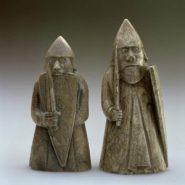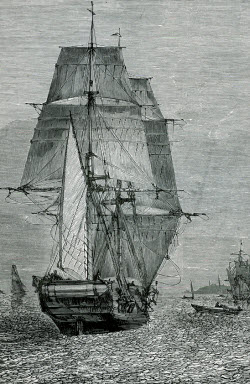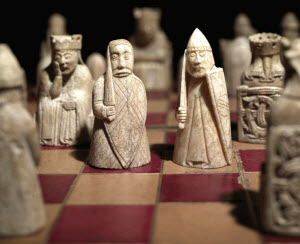The Incredible Lewis Chessmen

There is an old saying that ‘truth is stranger than fiction’ and occasionally we hear of a true story that has all the ingredients of a thriller like Indiana Jones but is far more fascinating because it is grounded in real life.
This is nowhere more evident than in the story of some old chess pieces found on the Isle of Lewis in the Outer Hebrides and now on display in the Royal Museum in Edinburgh and the British Museum in London. Although we cannot be sure of all the facts which are clouded by the passing of time there is a lot of evidence to support the following incredible story…
About three hundred years ago a sailing ship was caught in an Atlantic gale off the west coast of Lewis in the Outer Hebrides in Scotland. The ship escaped the worst of the storm by anchoring in a sheltered inlet called Loch Resort where the crew decided to stay until the storm subsided. One of the crew was a cabin boy who for some reason decided to escape from the ship while it was so close to land, presumably because of bullying which was very common on ships at this time. During the night while the crew were sleeping the boy swam to the shore but not before stealing from the ship’s Captain a few sets of precious ivory chessmen which he loaded into a sack.
 The boy managed to swim to the shore despite the weight of the sack containing approximately 100 chess pieces but was immediately confronted by a local cowherd who realised the sack probably contained something valuable. After an argument between the cabin boy and the cowherd a fight ensued during which the boy was killed. The cowherd quickly buried the body and then made off with the sack of chess pieces.
The boy managed to swim to the shore despite the weight of the sack containing approximately 100 chess pieces but was immediately confronted by a local cowherd who realised the sack probably contained something valuable. After an argument between the cabin boy and the cowherd a fight ensued during which the boy was killed. The cowherd quickly buried the body and then made off with the sack of chess pieces.
When the cowherd examined the contents of the sack he grew afraid of capture so carried the sack to another site ten miles distant known as the Mains of Uig where he then buried the sack beneath a sandbank.
We know about this sequence of events because many years later the cowherd was arrested for another crime and hanged in the islands main town of Stornoway. Just before he was hung however the cowherd confessed to killing the cabin boy and revealed the location of where he had buried the sack of chessmen.
Although searches were made at the time nothing was found and the story of the stolen chess pieces became just another local legend. Many years later though, in 1830, a man called Malcolm Macleod was walking his cows beside the same sandbanks when he noticed something sticking out of the sand. It was a small chess piece. Macleod began to scrabble in the same area and very soon uncovered the hoard of amazing chessmen. Macleod took all the pieces home but began to feel uncomfortable about having what he called ‘pagan idols’ in his house due to his religious convictions. Eventually he decided to hand them all over to a friend called Roderick Pirie who seems to have realised their potential value. Pirie took the pieces all the way to Edinburgh and sold them to an antiques dealer called Forrest for thirty pounds.
After much haggling by Forrest the pieces were then sold on to the British Museum for eight guineas. They were purchased by Frederick Madden who worked for the British Museum in the Manuscripts department but who was also a keen chess enthusiast and immediately recognised them as rare chess pieces.
In all Forrest had sold eighty two chess pieces to the British Museum but he held back ten pieces which he later sold to a Scottish genealogist called Charles Sharpe. Sharpe also managed to acquire another single chess piece found later in the same Lewis sandbanks making a total of eleven. When Sharpe died the eleven pieces were sold at a Christie’s Auction in 1888 to the ‘Society of Antiquaries of Scotland’. The Society of Antiquaries then donated them to the National Museum of Scotland.
 This then is the accepted amazing story of the Lewis chessmen and yet this is not the end of the story. In London at the British Museum Madden had been studying the chess pieces in detail noticing that each piece was of a unique warrior style, expertly carved from ivory and with some having been painted with dyes. In all there were ninety three pieces if you added the London and Edinburgh collections together consisting of 8 Kings, 8 Queens, 16 ‘Bishops’, 15 ‘Knights’, 12 ‘Rooks’ and 19 ‘Pawns’. Gradually Madden began to realise that the pieces were a lot older than previously thought and certainly not Scottish in origin. After much research experts concluded that the enigmatic chess pieces had been originally carved from walrus ivory and whales teeth in Trondheim, Norway at some time in the twelfth century. This is amazing in itself but there are further mysteries to consider. Chess was not a game commonly played in 12th Century Scandinavia although many other dice based board games were popular. The origins of chess lie way back in Iran or India two thousand years ago. So who made these incredible figurines and why? And how did they find their way to a ship moored off the coast of Lewis? Where did a sea captain find such a valuable hoard that probably made up five or five complete chess sets? And are there many more pieces still to be found beneath the sandbanks on Lewis? These are intriguing questions we may never know the answers to.
This then is the accepted amazing story of the Lewis chessmen and yet this is not the end of the story. In London at the British Museum Madden had been studying the chess pieces in detail noticing that each piece was of a unique warrior style, expertly carved from ivory and with some having been painted with dyes. In all there were ninety three pieces if you added the London and Edinburgh collections together consisting of 8 Kings, 8 Queens, 16 ‘Bishops’, 15 ‘Knights’, 12 ‘Rooks’ and 19 ‘Pawns’. Gradually Madden began to realise that the pieces were a lot older than previously thought and certainly not Scottish in origin. After much research experts concluded that the enigmatic chess pieces had been originally carved from walrus ivory and whales teeth in Trondheim, Norway at some time in the twelfth century. This is amazing in itself but there are further mysteries to consider. Chess was not a game commonly played in 12th Century Scandinavia although many other dice based board games were popular. The origins of chess lie way back in Iran or India two thousand years ago. So who made these incredible figurines and why? And how did they find their way to a ship moored off the coast of Lewis? Where did a sea captain find such a valuable hoard that probably made up five or five complete chess sets? And are there many more pieces still to be found beneath the sandbanks on Lewis? These are intriguing questions we may never know the answers to.
Wherever the truth lies there is undoubtedly a rare beauty in these enigmatic characters. So much so that a battle has raged for many years as to who really ‘owns’ the pieces. Clearly they were made in Norway but found in Scotland but possibly stolen from an English ship. In a way it is a shame that the collection is ‘split’ between London and Edinburgh with both cities claiming ownership. The good news however is that they are now permanently on show to the public so that everyone can admire the remarkable craftsmanship and beauty of these objects – one of the pieces was even featured recently in a Harry Potter film!
Whatever the true story behind these objects might be one thing is certain. It is indisputable that the Lewis chessmen represent one of the very few medieval chess sets that have survived the ravages of time and they still remain one of the greatest and most beautiful archaeological finds of the century.



